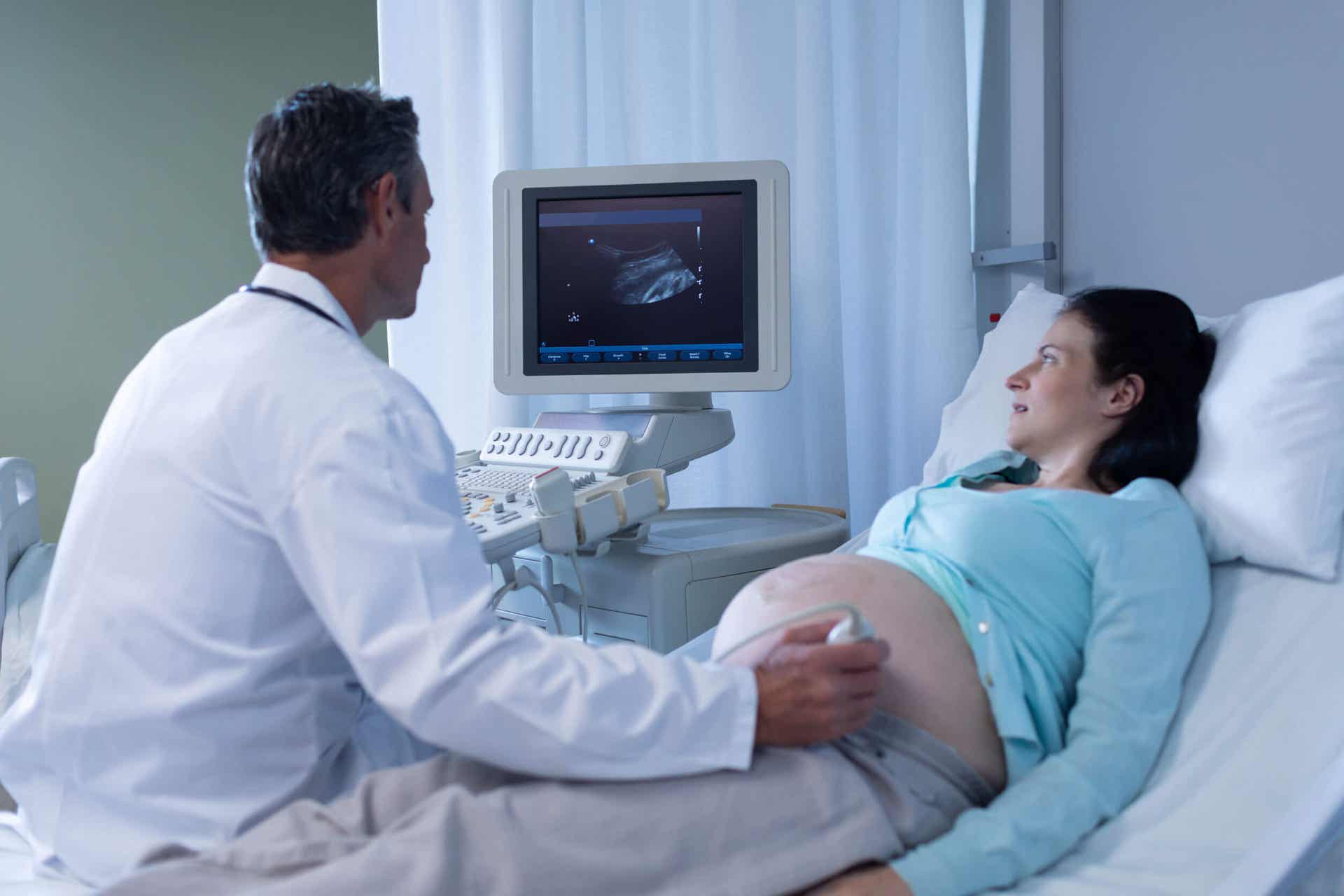How a Baby's Lungs Are Formed

The lungs are two structures located in the thorax that form a fundamental part of the respiratory system. The rest of the airways (such as the larynx and trachea) and the respiratory muscles are also part of this system. Did you know that the development of a baby’s lungs is a complex process? In fact, it’s not until the last weeks of pregnancy that the baby acquires the ability to breathe on its own. This is one of the reasons why premature births are dangerous.
Do you want to know a little more about this fundamental developmental process? Keep reading to learn some basic concepts about how the human body works.
A baby’s lungs: what’s fetal lung maturation?

Like any other organ or system, the maturation of the baby’s lungs is progressive and depends on several factors. These organs are essential for life. So, by the time of birth, they must be sufficiently developed in order to allow ventilation.
The latter process depends not only on the lungs, but also on the integrity of the respiratory muscles. The intercostals and diaphragm are representative examples within this group.
Inside the lungs, there are air-filled sacs called alveoli. In order for them to allow air to enter and exit without collapsing, they require a thin layer of liquid called surfactant.
It’s important to know all of these concepts. The proper development of the respiratory system depends on the integrity of all these structures and substances. If there’s a risk of premature delivery, doctors may prescribe steroids to accelerate some of this development.
How do a baby’s lungs develop?
The development of a baby’s lungs occurs in several stages, the first of which is the appearance and growth of the bronchi. These structures are part of the airway and are responsible for transmitting air from the trachea to the alveoli (and vice versa).
These bronchi gradually decrease in caliber, forming structures that basically perform the same function. An example is the bronchioles, which gradually develop until they reach the alveoli.
Surfactant is produced when the first sacs are already formed. This process depends on special cells that line the surface of the alveoli.
Why can it save the baby’s life?
Although the lungs are vital for life, their development is slow. This is understandable considering their complexity and importance. Generally speaking, before 34 weeks, they’re not ready to function in the extrauterine environment.
For this reason, when doctors detect a case of threatened preterm labor, mothers usually receive preventive treatment. This involves the administration of intramuscular glucocorticoids to promote the development of these organs.
Although these drugs usually have an immunosuppressive action, studies have shown that in pregnancy, they improve the synthesis of pulmonary surfactants. Thanks to this substance, the alveoli don’t collapse during the ventilation process, so the future baby could breathe adequately without the need for ventilatory support.
This doesn’t mean that these babies don’t require special care at birth. Most preterm deliveries require a stay in neonatal intensive care units (NICU), regardless of whether the baby appears normal.
Timeline of development

To make this process more educational, we’ll introduce you to the different stages of lung development. Let’s look at how they relate to the different weeks of pregnancy:
- Embryonic: this stage spans from week three to week six. The stem cells begin to form small, poorly defined structures that, in the next few weeks, will become the lungs.
- Pseudoglandular: from weeks seven to sixteen. The bronchial tree mentioned above begins to develop, first through the larger structures (main bronchi) and then through the smaller ones.
- Canalicular: this stage lasts from weeks 17 to 27. The branching of the airway begins to become more specialized, with the formation of some small alveolar sacs and some surfactants.
- Alveolar: from week 28 onward. The appearance of more alveolar sacs, once the larger structures of the bronchial tree are ready, characterizes this stage. Of course, this process is accompanied by the production of surfactants.
Although it may seem that everything ends at birth, in reality, that’s not the case. Many organs, including structures of the cardiorespiratory apparatus, continue to develop shortly after birth. This is the case of some alveolar sacs, which can continue to form even during the first two years of a baby’s life.
A baby’s lungs are a complex and valuable organ
Although at first glance, the lungs don’t appear to be very elaborate, from a microscopic point of view they’re complex. Therefore, their formation is far from easy. To ensure that they develop properly, following the obstetrician’s instructions is essential, as is regular prenatal care.
The lungs are two structures located in the thorax that form a fundamental part of the respiratory system. The rest of the airways (such as the larynx and trachea) and the respiratory muscles are also part of this system. Did you know that the development of a baby’s lungs is a complex process? In fact, it’s not until the last weeks of pregnancy that the baby acquires the ability to breathe on its own. This is one of the reasons why premature births are dangerous.
Do you want to know a little more about this fundamental developmental process? Keep reading to learn some basic concepts about how the human body works.
A baby’s lungs: what’s fetal lung maturation?

Like any other organ or system, the maturation of the baby’s lungs is progressive and depends on several factors. These organs are essential for life. So, by the time of birth, they must be sufficiently developed in order to allow ventilation.
The latter process depends not only on the lungs, but also on the integrity of the respiratory muscles. The intercostals and diaphragm are representative examples within this group.
Inside the lungs, there are air-filled sacs called alveoli. In order for them to allow air to enter and exit without collapsing, they require a thin layer of liquid called surfactant.
It’s important to know all of these concepts. The proper development of the respiratory system depends on the integrity of all these structures and substances. If there’s a risk of premature delivery, doctors may prescribe steroids to accelerate some of this development.
How do a baby’s lungs develop?
The development of a baby’s lungs occurs in several stages, the first of which is the appearance and growth of the bronchi. These structures are part of the airway and are responsible for transmitting air from the trachea to the alveoli (and vice versa).
These bronchi gradually decrease in caliber, forming structures that basically perform the same function. An example is the bronchioles, which gradually develop until they reach the alveoli.
Surfactant is produced when the first sacs are already formed. This process depends on special cells that line the surface of the alveoli.
Why can it save the baby’s life?
Although the lungs are vital for life, their development is slow. This is understandable considering their complexity and importance. Generally speaking, before 34 weeks, they’re not ready to function in the extrauterine environment.
For this reason, when doctors detect a case of threatened preterm labor, mothers usually receive preventive treatment. This involves the administration of intramuscular glucocorticoids to promote the development of these organs.
Although these drugs usually have an immunosuppressive action, studies have shown that in pregnancy, they improve the synthesis of pulmonary surfactants. Thanks to this substance, the alveoli don’t collapse during the ventilation process, so the future baby could breathe adequately without the need for ventilatory support.
This doesn’t mean that these babies don’t require special care at birth. Most preterm deliveries require a stay in neonatal intensive care units (NICU), regardless of whether the baby appears normal.
Timeline of development

To make this process more educational, we’ll introduce you to the different stages of lung development. Let’s look at how they relate to the different weeks of pregnancy:
- Embryonic: this stage spans from week three to week six. The stem cells begin to form small, poorly defined structures that, in the next few weeks, will become the lungs.
- Pseudoglandular: from weeks seven to sixteen. The bronchial tree mentioned above begins to develop, first through the larger structures (main bronchi) and then through the smaller ones.
- Canalicular: this stage lasts from weeks 17 to 27. The branching of the airway begins to become more specialized, with the formation of some small alveolar sacs and some surfactants.
- Alveolar: from week 28 onward. The appearance of more alveolar sacs, once the larger structures of the bronchial tree are ready, characterizes this stage. Of course, this process is accompanied by the production of surfactants.
Although it may seem that everything ends at birth, in reality, that’s not the case. Many organs, including structures of the cardiorespiratory apparatus, continue to develop shortly after birth. This is the case of some alveolar sacs, which can continue to form even during the first two years of a baby’s life.
A baby’s lungs are a complex and valuable organ
Although at first glance, the lungs don’t appear to be very elaborate, from a microscopic point of view they’re complex. Therefore, their formation is far from easy. To ensure that they develop properly, following the obstetrician’s instructions is essential, as is regular prenatal care.
All cited sources were thoroughly reviewed by our team to ensure their quality, reliability, currency, and validity. The bibliography of this article was considered reliable and of academic or scientific accuracy.
- Bianchi A, et al. Glucocorticoides prenatales. Documento Uruguayo de Consenso. Arch Pediatr Urug 2018;89(3):179-186.
This text is provided for informational purposes only and does not replace consultation with a professional. If in doubt, consult your specialist.








